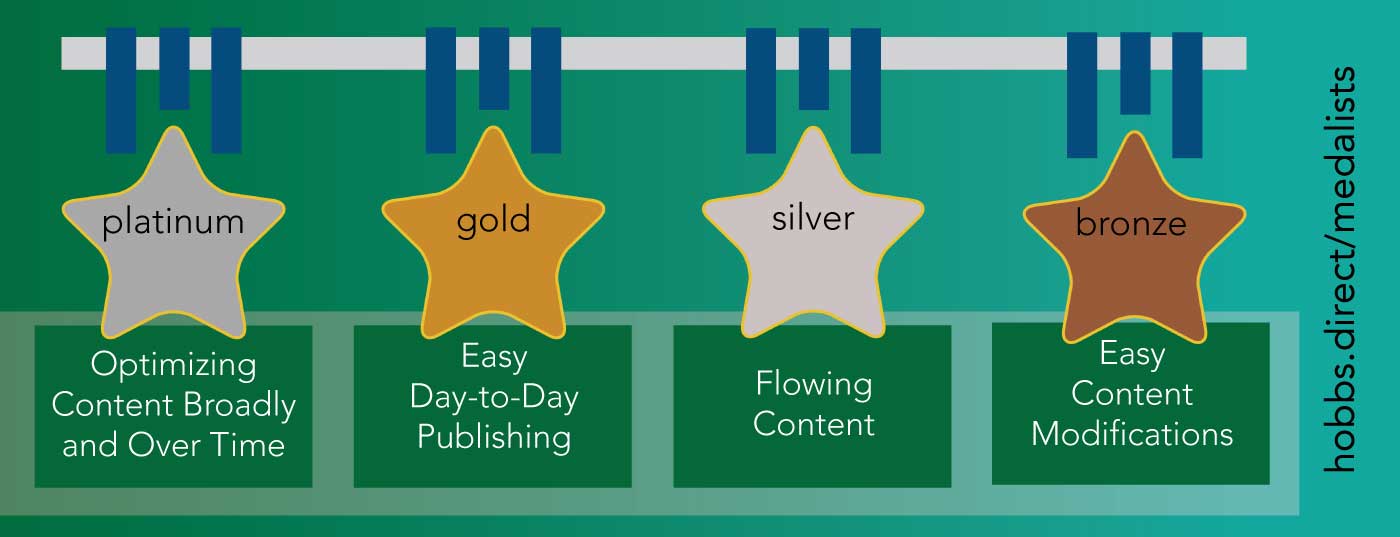Key Points
- Every organization has unique digital needs, but some common content management use cases are key
- During redesigns, concentrate on how you can architect the system to optimize broadly over time
- The most common, and frequently badly implemented, content management use case is easy, day-to-day publishing
Most CMS implementations miss the forest for the trees. They decompose the problem down to components, but in day to day use common activities are much too difficult. This leads to stagnation and workarounds, when digital presences should be dynamic and enable experimentation. Of course every organization has different digital presence needs, and there are certain table stakes requirements (responsive, modern, etc), but there are some key use cases that are both usually important and frequently botched.

Golden Use Case: Easy, Day-to-Day Publishing ← start here
You need to have...
common publishing tasks...
streamed and easy...
while building in high quality.
So easy to state, but difficult to pull off. Teams are often pulled by all sorts of what-if bells-and-whistles while overlooking the most common day-to-day tasks. For example, if you spend most of your time publishing timely news alerts, then that activity should be highly streamlined (rather than concentrating on all sorts of complex publishing that you might only do once a month).
[Read more about the Golden Use Case.]
Platinum Use Case: Optimizing content broadly and over time ← focus on this during redesigns
This one is so important but seems to elude most teams. I list the day-to-day publishing use case first since it is easier to understand, and also since it is one that can start being worked on today. Rippling through changes must be architected, so it something that can usually only be introduced during a redesign if it does not already exist.
Fundamentally, you need to be able to:
optimize and innovate over time...
across pages of a logical type...
that have already been published.
For instance, you may have thousands of report pages. Let's say you A/B test moving around some components of the page. Ideally you should be able to push out this change across all thousands of report pages without manual, page-by-page intervention.
[Read more about the Platinum Use Case.]
Silver Use Case: Flowing Content
Sometimes organizations can get away with a one-and-done approach to content publishing. For instance, a client once had an audience solely of extremely specialized lawyers who were very comfortable with a complex taxonomy, and so they could manually publish content in one specific place in a way that everyone could find it. But usually this isn't the way things work — your visitors may approach your content from any of multiple paths.
You need to have:
hubs of content...
controlled by a well-controlled taxonomy...
such that there are automatic, two-way linkages between content.
For example, if you have a blog and a main site that is topically arranged, then to satisfy flowing content you would need to be able to publish blog posts (tagged to the controlled vocabulary), have the blog post automatically appear over on the main site's topic pages, and have linkage from the topic pages to the blog post and vice-versa (so clicking on a topic from the blog could not trap the user over in the blog's rendetion of the topic).
Bronze Use Case: Easy Content Modifications
For a site to be dynamic and innovative, of course sometimes you need to change specific pages. Whereas the platinum use case is about broad change, here we look at individual content changes.
You need to have:
the ability to easily initiate editing the content...
easily make changes...
that are reliably published.
This one is relatively easy to implement but important to ensure happens.